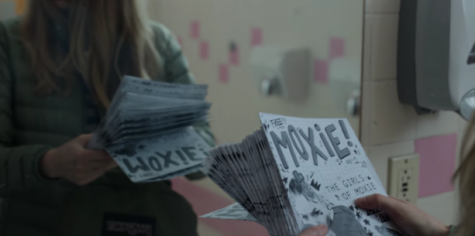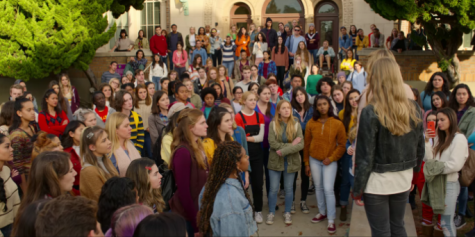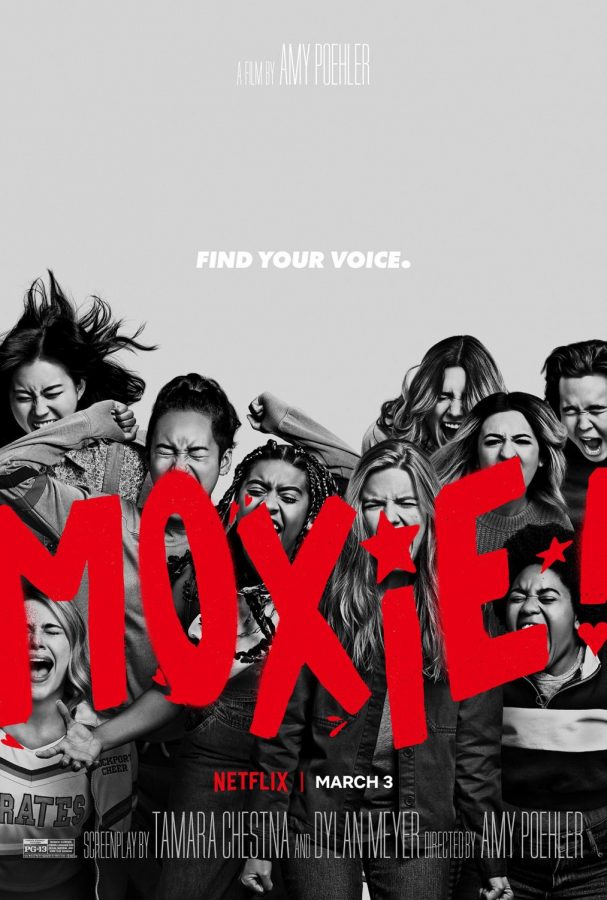“Moxie” has real moxie
March 11, 2021
Amy Poehler’s “Moxie” was released by Netflix on March 3, based on the Jennifer Mathieu novel of the same name. The film navigates the life of Vivian Carter (Hadley Robinson), a shy 16-year-old high school student who becomes empowered by her mother’s (Amy Poehler) past to spark a feminist revolution at her school.
The entwining of the riot grrrl movement of the 1990’s with present day teenagers created an inspiring revival of feminist culture with a spin, from Carter’s creation of riot grrrl inspired zines which created a feminist movement at her school that heavily drew on support from social media to the soundtrack peppered with Bikini Kill as well as current hits.

Carter begins the movie as obedient and diminutive, but after Lucy (Alycia Pascual-Peña), a new student, opens her eyes to the misogynistic culture present in her school that has become normalized, such as rampant harassment and the male students’ rating board of the girls, Carter decides to start an anonymous zine titled ‘Moxie’ which calls the students of her school to action. As the film progresses, Carter meets women who identify with the zine and her new boyfriend Seth (Nico Hiraga) as she discovers her own identity. As the movement begins to gain momentum and clash with school administration, divisions between the women of the school collapse and erupt into a revolt against the sexist ideals which permeated their school environment.
I definitely feel that this was an important narrative to be told, especially because I haven’t seen a film directly focus on the issues which most women face seriously while also maintaining a typical high school coming-of-age story.

This film made a strong effort to be inclusive of women of different backgrounds and stand as an example of intersectional feminism. Although using the riot grrrl movement as a jump off point, the movie points out the faults of the movement for not being inclusive enough to women of color and LGBTQ+ women and sets out to address them within a current high school lens. For example, Carter’s best friend, Claudia (Lauren Tsai), confronts Carter for failing to recognize the specific hardships she faces as an Asian woman and a child of immigrant parents.
However, the movie, attempting to tackle so many issues at the same time, failed to do much else than simply gloss over most of these problems. Although inhabiting a cast of characters which included many young women of color, sapphic women, and a transgender woman, most attempts to delve into the struggles of these characters ended up with a surface level line or two. Carter was the heart of the book, but I felt that it would be more effective to tell the story from more than one perspective within the film since the script had already diverged from the novel by including a more diverse group of characters in the first place.
Another fault of the film was many of the other deviations from the original source material that made the story much more superficial and less cohesive. The dialogue, unlike that of the novel, felt stilted and unrealistic, inhibiting the relatability of the characters. It sometimes felt as though the writing’s goal was to pander to the current way teenagers behave and interact rather than create genuine and believable conversation. Significant plot points from the book were removed, many of which made the main character, Carter, less likeable and outright irritating during some portions of the movie. Although I recognize that the film tried to make her character nuanced and convey the message that it’s okay to make mistakes and learn from them, I believe some of her actions went too far and weren’t necessary in order to deliver this point.
Despite its shortcomings, “Moxie” is still an enjoyable movie that has real sentiment and wholehearted passion behind it. Although its message may be simple, the film serves as a rallying cry that acts as an entrance to learning about sexism that continues to prevail in our society and a first stepping stone in contributing to the solution.

